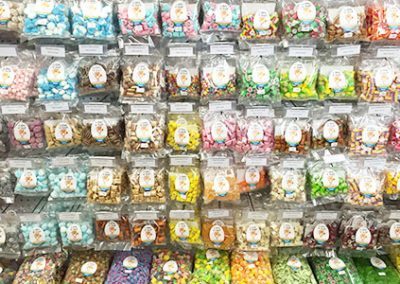I Luv Candi Can Be Fun For Everyone
I Luv Candi Can Be Fun For Everyone
Blog Article
More About I Luv Candi
Table of ContentsI Luv Candi Things To Know Before You BuyI Luv Candi Fundamentals ExplainedGetting The I Luv Candi To WorkThe Best Strategy To Use For I Luv Candi7 Easy Facts About I Luv Candi Explained
You can additionally approximate your very own income by applying different assumptions with our monetary plan for a candy store. Typical regular monthly profits: $2,000 This kind of candy store is typically a little, family-run company, perhaps known to citizens however not drawing in multitudes of tourists or passersby. The shop may provide a selection of usual sweets and a few homemade treats.
The shop does not usually carry uncommon or costly items, concentrating rather on economical treats in order to keep routine sales. Assuming an ordinary costs of $5 per customer and around 400 consumers monthly, the monthly profits for this sweet-shop would certainly be about. Typical month-to-month profits: $20,000 This sweet-shop take advantage of its critical place in an active metropolitan location, drawing in a lot of clients trying to find sweet extravagances as they shop.
Along with its diverse sweet choice, this store could likewise sell related items like gift baskets, sweet bouquets, and novelty things, supplying multiple revenue streams. The shop's location calls for a higher allocate lease and staffing but brings about greater sales volume. With an approximated typical spending of $10 per client and about 2,000 consumers per month, this shop could create.
Getting The I Luv Candi To Work
Situated in a major city and visitor destination, it's a huge establishment, usually spread out over several floorings and perhaps part of a national or worldwide chain. The shop supplies an immense variety of candies, including special and limited-edition products, and goods like well-known apparel and accessories. It's not just a store; it's a destination.
The operational costs for this type of shop are substantial due to the location, dimension, personnel, and includes supplied. Thinking an ordinary purchase of $20 per customer and around 2,500 consumers per month, this front runner store could attain.
Group Examples of Expenses Ordinary Month-to-month Price (Variety in $) Tips to Decrease Expenses Rental Fee and Utilities Store rent, electricity, water, gas $1,500 - $3,500 Take into consideration a smaller sized place, negotiate rental fee, and utilize energy-efficient lighting and devices. Stock Candy, treats, product packaging materials $2,000 - $5,000 Optimize inventory management to reduce waste and track popular things to avoid overstocking.
The 8-Minute Rule for I Luv Candi
Advertising And Marketing Printed matter, on the internet ads, promotions $500 - $1,500 Concentrate on cost-efficient electronic advertising and use social media systems free of charge promotion. Insurance policy Company obligation insurance policy $100 - $300 Look around for competitive insurance policy prices and consider bundling plans. Equipment and Maintenance Sales register, display shelves, repair work $200 - $600 Buy used tools when possible and do normal upkeep to extend equipment lifespan.

This suggests that the candy store has reached a point where it covers all its fixed expenses and begins creating revenue, we call it the breakeven factor. Take into consideration an instance of a candy store where the monthly fixed prices typically total up to about $10,000. A harsh quote for the breakeven point of a candy shop, would certainly then be around (since it's the complete set expense to cover), or offering between with a rate array of $2 to $3.33 per system.
The Ultimate Guide To I Luv Candi
A huge, well-located sweet store would undoubtedly have a higher breakeven factor than a little shop that doesn't require much revenue to cover their expenditures. Curious concerning the earnings of your candy store? Try our easy to use financial plan crafted for sweet stores. Merely input your very own assumptions, and it will aid you determine the amount you need to gain in order to run a successful company - chocolate shop sunshine coast.
Another threat is competition from various other sweet stores or larger merchants that might provide a broader selection of products at lower costs (https://packersmovers.activeboard.com/t67151553/how-to-connect-canon-mg3620-printer-to-computer/?ts=1711568941&direction=prev&page=last#lastPostAnchor). Seasonal variations sought after, like a decline in sales after holidays, can additionally affect productivity. Furthermore, transforming consumer choices for healthier snacks or nutritional restrictions can minimize the appeal of standard sweets
Financial recessions that minimize customer investing can affect candy shop sales and productivity, making it important for candy stores to handle their expenditures and adjust to changing market conditions to stay rewarding. These hazards are typically included in the SWOT analysis for a sweet-shop. Gross margins and net margins are key signs used to determine the earnings of a sweet shop business.
Our I Luv Candi PDFs
Essentially, it's the profit continuing to be after subtracting costs directly pertaining to the sweet stock, such as acquisition expenses useful reference from providers, manufacturing expenses (if the sweets are homemade), and personnel salaries for those associated with production or sales. https://penzu.com/p/ba810873cdbad232. Net margin, conversely, variables in all the expenditures the candy store sustains, consisting of indirect costs like administrative expenditures, advertising and marketing, lease, and taxes
Sweet shops typically have an average gross margin.For circumstances, if your sweet-shop gains $15,000 each month, your gross revenue would be about 60% x $15,000 = $9,000. Allow's illustrate this with an instance. Take into consideration a sweet-shop that marketed 1,000 candy bars, with each bar valued at $2, making the overall revenue $2,000 - pigüi. Nevertheless, the store incurs costs such as acquiring the candies, energies, and incomes up for sale staff.
Report this page